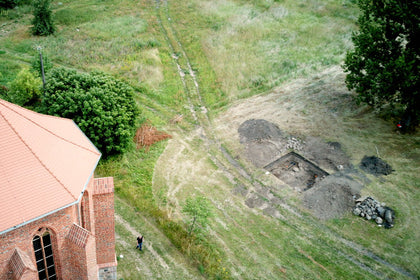2019
OKM joins excavations near the Templar Church in Poland and explores the site with 3D ground scanner OKM eXp 6000 and radar OKM Gepard GPR 3D.

Dedektör
OKM Rover C4
Bölge: Chwarszczany, Poland
OKM joins excavations near the Templar Church in Poland and explores the site with 3D ground scanner OKM eXp 6000 and radar OKM Gepard GPR 3D.
Further explorations inside the church with 3D ground scanner OKM Rover C4 prompt further excavations.
Resumed excavations in front of the Templar Church are accompanied by the Discovery Channel film team for an episode in Expedition Unknown.
OKM followed the invitation of the history and culture association S.H.K. "Tempelburg" and joined a meeting with the magazine Odkrywca, the magazine Relikte der Geschichte as well as treasure hunters of the YouTube team 'Sondelsüchtig'. As detector manufacturer from Germany, OKM was able to support future archaeological projects within the project "Chwarszczany" (Slowianie Templariusze Projekt) with ground measurements. Read more about the previous excavations by the expert Dr. Przemyslaw Kolosowski and what was detected and found during the current exploration.
The impressive early gothic building with its two narrow towers stands out from afar. At first the towers appear to be of defensive function of a castle, in fact they are supporting pillars of the Templar Church.
The church is located in the village Chwarszczany at the river Mysla in West Pomerania, Poland. It was built on the foundations of earlier settlements and was the administrative centre (Commandery) of the Templars, serving as the headquarters for meetings, probably also as a storage place for relics and treasures. In addition to the chapel, further utility and residential buildings belonged to the estate.
After the dissolution of the Order of the Templars, the property was handed over to the Order of Saint John in 1318. They not only redesigned the interior of the church, but also added parts of the building around the chapel. One of the foundations was uncovered during archaeological excavations in 2004. The eventful history of the chapel continues to tell of the conflicts of the Order of Saint John with the Teutonic Order, from which the property was taken in the 15th century. After the relocation of the Johanniter seat in 1540, the chapel became a Protestant church. Since 1945, the chapel is Roman Catholic church.
Excavations have been taking place in and around the chapel since 2004. The team of historians and archaeologists is researching the architecture of the chapel in order to further reconstruct its original functions.
References to earlier settlements such as pottery, iron nails and other archaeological finds dating from the Bronze Age and the Middle Ages have already been found. Old wall remains have also been uncovered, other structures are still hidden, but have been detected with ground scanners by OKM.
With the ground radar Gepard GPR and the 3D ground scanner Rover C4 measurements were carried out on the south side of the Templar chapel. Anomalies between the neighboring well and the remains of the foundations next to the church were localized by both devices and thus confirmed first speculations.
Gepard GPR scan images show significant anomalies at a depth of about 3.7 to 6 m in loamy and sandy soil (circle). The diagonal lines (below circle) are reflections of the church. The Ground Radar technology also records such influences of buildings. With the Rover C4 various measurements were performed. The ground scanner was used with the 100 cm vertical Super Sensor. The evaluation of the data took place via tablet PC and software "Visualizer 3D". The Rover C4 measurements next to the church also determine a possible non-metallic anomaly in the measured area.
A live scan with the magnetometer mode of the Rover C4 marked the extent of the reinforced concrete construction at the well. This concrete structure is larger than the entrance, which was secured with concrete slabs, implies. Further measurements and investigations will show whether the cavity is an underground passage or even an escape tunnel.
Under the church, an underground cavity such as a crypt or a tomb is also suspected. This assumption has been confirmed with the Rover C4: With its function as pin pointer with LED orbit, conspicuities were displayed directly and inspired the team of archaeologists.
Meanwhile, the excavations at the Templar Church have also attracted the interest of the renowned explorer Josh Gates. In his Discovery Channel series Expedition Unknown, he continues the search of the Templar treasure and soon arrived at the site in Chwarszczany.

Expedition Unknown Season 10, Episode 5 "Knights Templar Treasure Hunt": Josh searches England and Poland to unearth the secret world of the Knights Templar, the legendary warriors rumored to have amassed the coveted Holy Grail.
The historical and cultural association S.H.K. Stowarzyszenie Historyczno Kulturalne "Tempelburg" is an organization to preserve, care and protect Polish cultural heritage, national traditions as well as cultural consciousness. The team of professional archaeologists and amateur historians share a common passion for exploration and history. www.tempelburg.pl
www.facebook.com/stowarzyszenietemplum/
Dr. Przemyslaw Kolosowski is an archaeologist and author of articles on the history of the Templars in Poland. Together with his team he offers archaeological services such as supervision and management of excavations. www.nadzorarcheo.pl
Explorer and television presenter Josh Gates investigates the world's most iconic and captivating legends. In 2018 at the start of the fifth season, Expedition Unknown moved to Discovery Channel, which became the new home for the series and its spinoffs. The 10th season premiered in May 2022.
You have also made discoveries and detected amazing artifacts and would like to share them (anonymously)? We look forward to reading and publishing your success stories!























